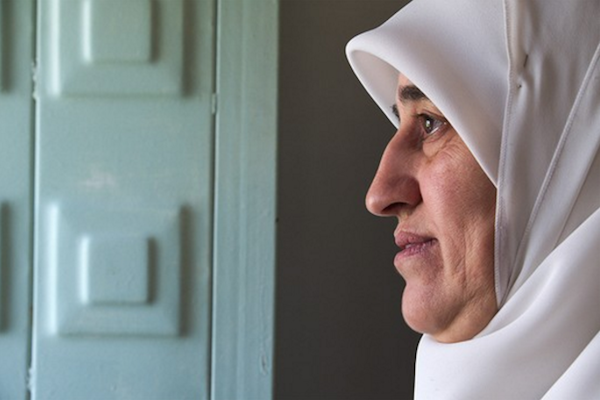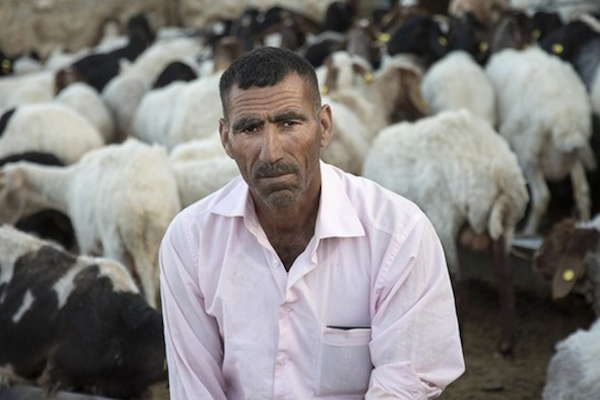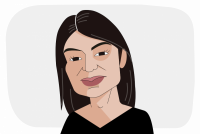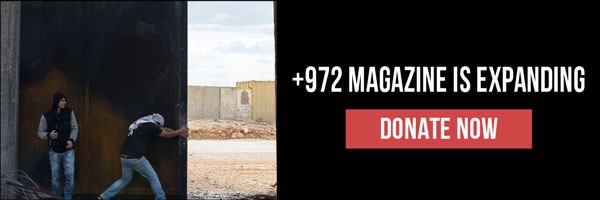A new exhibit by B’Tselem marks 50 years of occupation with portraits of 50 Palestinians born in the occupied territories, who have never known a day of freedom in their lives.

There is a checkpoint next to my house. It determines my life’s routine. It is a source of constant worry: whenever my children are on their way home from school or to another place, I’m worried. I want to travel, to sit on the beach, to visit Al Aqsa and my family in Jerusalem. But because of the checkpoints, I can’t. Sometimes it takes hours to cross the checkpoint. I just sit and lean against the grates. — Kharbiyeh Marwani, Hebron.
Last Friday, B’Tselem opened a photo exhibit at the Jaffa Art Salon to mark the 50th year of the occupation of the West Bank and Gaza Strip. More than 40 photographers, men and women, took portraits of 50 Palestinians, residents of the West Bank, East Jerusalem, and the Gaza Strip.
The subjects of the portraits come from different backgrounds and walks of life: from cities and villages, from refugee camps and communities under threat of expulsion, affluent and poor. But they all have one thing in common: they have never known a day of freedom in their lives.
Since its establishment 28 years ago, B’Tselem has documented human rights abuses in the occupied territories and attempted to raise the Israeli public’s awareness of these abuses. Contrary to the claims that the Right likes to make against human rights organizations, B’Tselem’s target audience is, and always has been, the Israeli public — which has not only a right but an obligation to know what happens in its name. At a time when Israelis are increasingly indifferent to anything having to do with the occupation, this exhibit attempts to bring the faces of Palestinians living under military rule to the Israeli street.
I was thrown in jail when I was 23. I was released 22 years later, when I was 45. While I was imprisoned, my children grew up and got married. When I think about freedom, I think about the time I spent behind bars. — Zuheir A-Shashineh, Al Burg refugee camp, Gaza.
It is difficult to imagine a starker contrast: the Jaffa port on a Friday afternoon, the pleasant early-winter sun, the packed coffee shops and bustling promenade, and inside the gallery space, 50 subjects living under occupation looking straight at the camera, trapped within their frames. The striking exhibit is accompanied by a high-quality booklet; it is recommended that one look through it during one’s visit. In the booklet, the portraits appear with a few sentences from interviews conducted with their subjects; they speak about the concepts of home, freedom, occupation, and hope.

The Palestinian photographers could not make it to the exhibit’s festive opening in Jaffa. They were denied permission to enter — an almost a poetic illustration of the reality that the pictures present, a reality in which your every move depends on the goodwill of the regime under which you are a subject without rights, without citizenship, deprived of any ability to influence the decisions that affect the most basic aspects of your life.
Wandering among the photos is a powerful experience. Most of the portraits’ subjects look directly at the camera. Some are photographed alone, some with members of their family. Occasionally, a photo catches the eye with a hint of humor, like the picture of a boy standing next to his father holding a kite with the colors of the rainbow flag.
As I move between the photos I wonder, how is it possible that after 50 years, it is still necessary to convince Israelis of the fact that behind that tired word — occupation — there are human beings, flesh and blood. And how have we managed to repress the knowledge of the existence of millions of people who for decades have dealt with a reality that we would not be willing to endure for even an hour? What stops us from going to meet these people, who in some cases live just a few minutes away, to speak with them and, mostly, to listen to them? How is it possible that after 50 years, a human rights organization needs to devote an entire exhibit to remind Israelis that behind the separation barrier and the fear, there are people — an entire nation — living under brutal oppression, who spend much of their lives waiting at checkpoints, facing expulsion and imprisonment?
I think freedom is the most beautiful thing in the world — the ability to travel wherever you want, to breathe new air. — Aida Nassar, Jabaliya refugee camp, Gaza.
In this sense, the portraits encompass not only the stories of life under occupation, but also a guilty verdict against Israeli society, which has willingly chosen to ignore the reality of the occupation. After 50 years, at the very least, we owe this to the people whose freedom we have stolen: to look them in the eyes, even if in an aestheticized safe space in the heart of Jaffa. As it is written in the exhibition’s booklet: “Look at the faces of the occupied and see, ‘God created man in his image, in God’s image he created him.’ Their faces also tell our stories, and our faces are reflected in theirs.”
The exhibit will be shown until December 7.
This post was first published in Hebrew on Local Call. Read it here.


